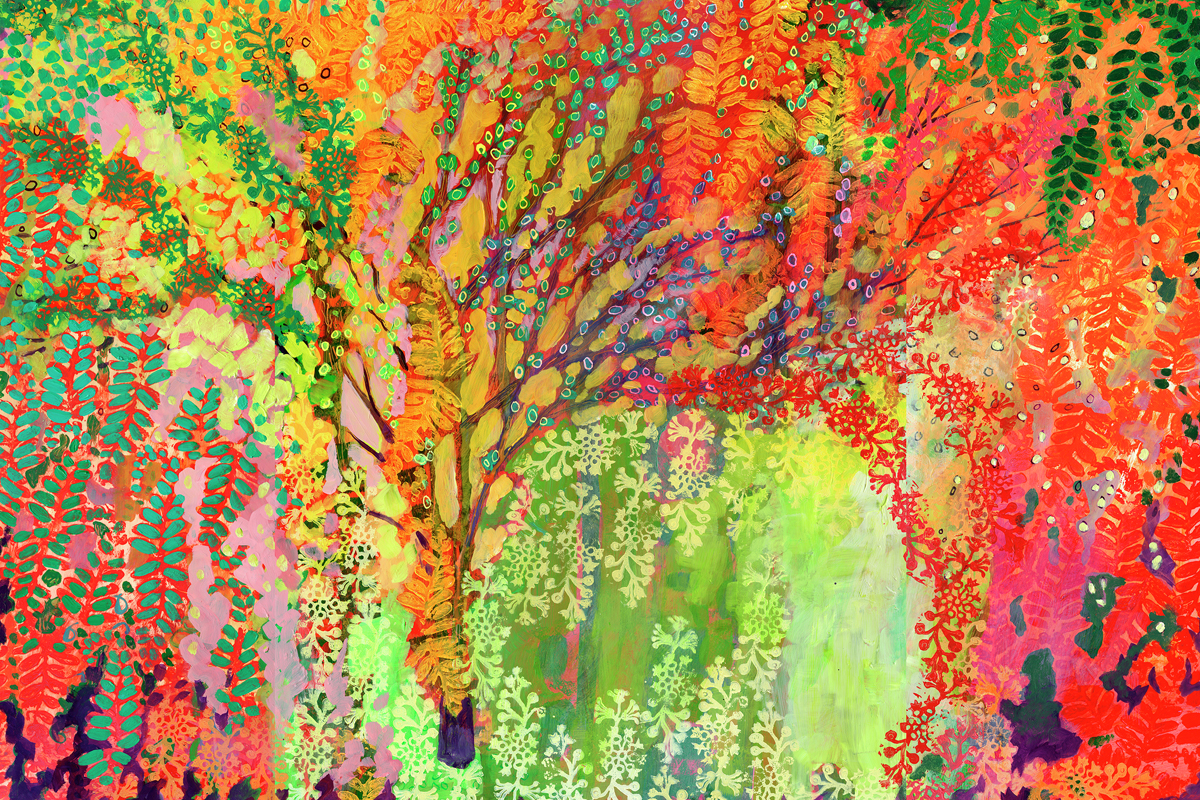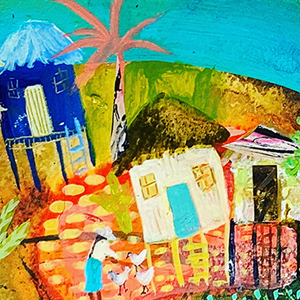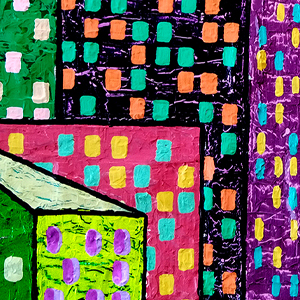
Abundant Virtue
Generosity in Everyday
Academic Life
Notes on First Principles
Laurie L. Patton
Artwork: “Immersed in Summer” by Jennifer Lommers © 2019
The following thoughts are notes toward a hermeneutic of generosity in everyday institutional life in higher education. I first consider the two specific ways in which, in twenty-first-century academic life, we literally cannot see or name generosity. I then move to how religious traditions, with their deep-rooted ideas about generosity, embed this disposition in their educational institutions. A discussion of the role of religious traditions in promoting generosity in education is not just necessary, but enlightening. It can guide us in rebuilding our current institutional lives and deserves more philosophical reflection.
The Need for Imagination
I recently met two friends whom I consider generous. They are accomplished senior academics who freely give their time, talent, and even treasure to their students, colleagues, and the people who attend their public lectures. In their written and spoken words, they are charitable and fair-minded toward other scholars, teachers, and students, including their critics.
In our meeting, I asked my colleagues about their most recent grants. They were able to answer almost immediately. Most scholars can name a travel grant, a book subvention, or research funding that will allow them months, and sometimes even years, of sabbatical writing and thinking. However, when I asked if they considered the grants generous, they said no. Most grants can barely fund a sabbatical salary, and only scholars at the most well-endowed institutions can have their grant money supplemented to make up their usual salary.
This scenario illustrates how we have lost our human (and humane) capacity to imagine generosity in the academy. The very idea of a grant is a form of trust; it derives from the Latin credere, “to entrust,” through the old French creanter, “to guarantee,” and related granter “to consent to support.”1 Moreover, grants involve humans’ collective deliberation—and subsequent giving—to other humans. However, in contemporary academic life, they are primarily understood as a bureaucratic transaction of inadequate support. Such transactions have recipients who use the wealth to advance individual or collective research, which in turn enhances the institution’s prestige. Grants are viewed as part of the financial and prestige economy, not human ones.
In addition to losing a sense of the human gift involved in the financial life of the academy, there is a second way we have lost this imagination for generosity. When I asked my colleagues to consider their most recent moment of generosity towards someone else or the most recent moment of someone else’s generosity toward them, they had a hard time thinking of one. This is not because those moments didn’t exist. Knowing my colleagues, I guessed that such moments of magnanimity probably existed in abundance. Instead, my friends did not have the habit of thinking about institutional life in these terms. Very few of us in the academy have this habit. That is in part because generosity involves human expectations of what is enough. The Cambridge Dictionary defines generosity as “a willingness to give help or support, especially more than is usual or expected.” Generosity involves social, cultural, and political ideas of what should be the case and how much should be a usual part of the regular business of academic life.
But in 2024, the regular business of the academy will be hotly contested. Educational institutions are often considered, at best, rule-governed but unpleasant necessities. At worst, they are perceived as neo-liberal corporatized spaces of inevitable oppression. This understanding of institutions of higher education also crosses political boundaries. Such tropes are most often used by the left and far left to criticize wages that have not kept up with inflation or classroom practices that stifle minority students’ access to genuinely authentic learning experiences. But I have also heard the tropes used by conservatives. Minus the neo-liberal moniker, the phrasing is used as a way of criticizing the establishment bureaucracy (equally corporate, just understood as originating from the left), which forces DEI orthodoxies on professors who would prefer to be left alone to exercise their freedom of speech and academic inquiry in the classroom.
Institutions of higher education are caught in the middle of this ideological polarization, and those who work in them struggle to perceive generosity or acknowledge it in others, much less than themselves. My colleagues didn’t know how to think about what was “enough” or “usual,” and so they were at a loss as to how to determine what was “going above and beyond.” They didn’t imagine themselves exceeding the usual limit because they didn’t know it.
Examples abound of this kind of indeterminacy. As a college president, I regularly argue with trustees about spending for wages, asking for more. I also try to persuade them to spend slightly more than they are comfortable with to push our institutional vision and support our faculty and staff in other ways. I argue with them about ensuring our highly valuable benefits package is retained. We usually come to some compromise—not enough for me and too much for them. However, while I wish they saw things the way I did, I also know that every single one of the members of the board of trustees is deeply philanthropic—as generous with their time, talent, and treasure as the colleagues whose story opened this article are. I recognize their generosity, and it is my obligation to do so. That is one side of the equation.
The other side of the equation is the inevitable perception that no matter our collective decisions, those decisions are rarely seen as generous. This state of affairs is partly because the decisions can amount to less than people want or expect. However, I think there is also a deeper reason for this perception. Decisions made by people who follow a system are rarely seen or described as generous. According to the logic of the twenty-first-century academy, a bureaucratic system, by its very nature, cannot be gracious. As an educational leader, I recently experienced a powerful example of this. When COVID hit hardest, we had the means to keep everyone employed, keep everyone’s benefits, and furlough no one. I and many others at my institution and in the community understood this as an act of institutional generosity. Most other businesses and academic establishments were not doing this. The decision cost us about sixty million dollars over two years. But others complained that we were following ruthless and inhumane corporate logic because we kept wages flat. As we were coming out of COVID, when we gave only 7% raises but not 20% to keep pace with inflation, people complained that we were, as an institution, stingy and uncaring. They felt this was the case even though they acknowledged that 7% was still one of the highest raises in the state and amongst our academic peers. In the larger context of COVID and its aftermath, many felt our care for our people was greater than most institutions. However, for others, it could have been far greater. We literally could not see our way to a common definition of generosity. And we lacked the vocabulary and collective will to find it.
This COVID experience taught me that, according to most contemporary definitions of charity, individuals can be generous, but educational institutions cannot. Generosity is perceived as a deeply personal virtue involving personal motives and a person’s spiritual state. It is not understood as the product of careful thinking by humans working within a system. But I want to ask a challenging question about this twenty-first-century condition: what if, in our collective institutional deliberations in higher education, we could discuss with generous motives and arrive at generous conclusions?
Religious Systems as Resources
Over the course of my career as a scholar of religion, I have learned that there are such conceptual connections between generosity and educational systems during several moments in human history. In the history of religious institutions, charity and education have been bound by each other. Founders of such educational systems are remembered for their generosity and become figures in exchanging educational goods. Educational systems, as well as educators themselves, are understood as means of developing spiritual merit and, therefore, valuable objects of generosity. Moreover, teachers and teaching are considered a sacred gift of the self.
Institutions
A cursory examination of some examples from the traditions commonly known as world religions may suffice as preliminary notes. In the Jewish tradition, giving to a scholar or offering support to a Beit Midrash, or house of learning, has been considered one of the highest forms of giving. Ancient Jewish laws allow a person to give no more than 1/5th of their income to charity, but if one wants to give to a scholar, one can provide more than 1/5th.
In ancient India, danam, or giving in general, was a name for a sacrificial offering as well as a gift to a person in need. It was also a term for giving to a public project, such as a temple or water works, that would benefit all. The ancient gurukul system of teachers and students depended on reciprocal gift giving: the student brought gifts of water and fuel to be accepted into the teacher’s home. The teacher, in turn, gave the gifts of hospitality, wisdom, and knowledge. This ancient system provided an alternative to the idea of danam as strictly a sacrificial transaction with the gods.
Relatedly, in Buddhism, giving was understood as a fundamental Buddhist practice, and when connected to the critical dispositions of morality, concentration, and insight, it furthered the practitioner’s path to enlightenment. Giving to the sangha, or Buddhist monastic community, with pure intention and in the appropriate way is still one of the central ways to earn spiritual merit in traditional Buddhist communities. From its beginning, the sangha has been understood as an educational institution, a community of learners working toward enlightenment. Indeed, the highest form of charity is not giving a material gift, but when monks teach the dharma or Buddha’s teaching, on the path to enlightenment.
From the fourth century onward, Christian monasteries were known as seats of learning and prayer, and their regular activities included the education of townspeople in addition to scholarly study within their community. During the medieval period, many wealthy aristocrats gave copiously to monasteries for their souls to be saved. They also donated because the institutions as seats of learning had become economic engines for entire communities. The first European universities developed from these Roman Catholic monastic schools. The earliest groups of students and faculty, gathering in the eleventh and twelfth centuries in Bologna and Paris, added Greek and Roman knowledge, as well as mathematics, logic, and other forerunners of contemporary scientific method, to their curricula.
In the tenth century, two women from the Muslim community sponsored al-Qarawiyyin, an institution of higher learning in Fez, Morocco, one of the oldest continually operating universities in the world. According to its origin legend, it was established by the generosity of Fatima, the daughter of a wealthy merchant, who felt that creating a mosque with an educational program attached was the best thing to do with the inheritance from her father. Most mosques had a madrasa, or seat of learning, in addition to their religious activities. Madrasas sponsored halaqas, or circles of teaching and learning, where grammar and legal reasoning were part of the curriculum. These circles of teaching were part of why a mosque was valuable to a community and a frequent recipient of charity. Giving to a mosque was a way to purify one’s wealth.
From their earliest moments, educational systems within different spiritual traditions depended on generosity and integrated it conceptually into the very idea of an institution. Giving was differently configured depending on the worldviews of the traditions, including the specifics of spiritual merit and the afterlife. Whatever the worldviews, however, educational institutions still carried with them the memory of their creation and continuity by actual humans. Both donors and recipients had a human face.
Teachers
This idea of institutions with a human face brings us to our second form of religion as a conceptual resource. As mentioned above, we are missing the vocabulary of generosity in everyday institutional life. (Recall my colleague’s inability to tell stories of generosity from their own careers, even though plenty existed.) From their earliest foundational texts, however, religious traditions have such vocabulary in the form of reverence for the teacher and the teacher’s generosity. Stories and precepts abound in religious traditions about how teachers share abundantly.In Judaism, reverence for a teacher is central. The Talmud (Talmud Yerushalmi, Hagigah 1:7) teaches that the true guardians of a community are teachers, and the sayings of the fathers, Pirkei Avot 4.12 argues that one should “revere your teachers as you would heaven.” Abraham Joshua Heschel also wrote, “What we need, more than anything else, isn’t textbooks but rather text people. It is the personality of the teacher which is the text that students read—the text that they’ll never forget.”2 A Jewish prayer exists specifically for teachers at the end of the period of study.3
In the Hindu tradition, Guru Purnima is a Hindu holiday on which people honor the guru, or teacher, with gifts as an act of remembrance for all the knowledge the guru has shared. Offerings are made to living teachers as well as to those who have passed away, and, according to one commentator, the idea of such remembrance is to “awaken our own generosity to share knowledge with others and to support those who seek and impart wisdom.”
From its inception, Buddhist tradition has offered the dharma teaching for free. This is an essential principle of monastic and lay life that still operates today. One monk writes how important it is that “amid contemporary Western culture, our teachers are continuing the ancient Buddhist monastic tradition of freely offering the teachings.4 Danam is for the upkeep of the institution that supports the teaching, but the teaching itself should always be an act of generosity.
In the Christian New Testament, teaching is essential to the discipleship of Jesus. As Jesus puts it in Matthew 30, his followers must teach everything he has told them. Moreover, teaching in concrete form, from one human being to another, is essential to Paul’s ideas of the early church and its formation. Paul puts it in Colossians 3:16 to the early Christian followers: “Let the word of Christ dwell in your richly, teaching and admonishing one another.”
The power of the individual teacher has also been central to foundational texts within Islam. In the Surah al Baqarah of the Qur’an itself, the prophet is compared to a teacher who shares purifying wisdom. Hazrat Ali also has a famous saying, “If a person teaches me one single word, he has made me his servant for a lifetime.” In another Hadith (Al Bukhari 8.3), Uthman Ibn Affan attributes the Prophet with the saying, “The best of you is he who learns the Qur’an and teaches it.”
Contemporary madrasa teachers frequently refer to teaching as makarim, a form of good conduct that draws someone closer to the attributes of God, including the qualities of “kindness, generosity, knowledge, and forgiveness.”5
These cursory perspectives on religious traditions show something important about the transformational power of the individual teacher in quotidian life. Everyday teaching is an act of sharing oneself that brings one closer to a spiritual goal, whether it is the acquisition of divine attributes or spiritual enlightenment. Teaching is not only transactional labor for an institution whose very structure is perceived to be self-serving.
Concluding Thoughts and Questions
In many world religions, the spiritual grounding of education, both in its institutional and individual forms, is the idea that education itself is an act of generosity. Such an idea is almost impossible to imagine in the contemporary academy. But if we took it seriously, several important corollaries might follow. We might recover a language, a vocabulary, for talking about our own lives and those of others with a view toward magnanimity—the above and beyond-ness of education as an act of sharing. Second, could we rethink our systems so that they become humanized again—not only in our educational practices but also in the idea of an educational system itself? Could faculty, staff, and students view collective deliberations about financial policy as part of the generosity of individual decision-makers and policymakers, not just the perpetuation of a self-interested system? Finally, could we reimagine rewards for teaching in terms of gratitude, not the performative or obsequious kind, but the one that places indebtedness for the sharing of self at the center of the discourse?
Notes
- Oxford English Dictionary, “Grant,” oed.com/dictionary/grant_v?tab=etymology.
- Abraham Joshua Heschel, “The Spirit of Jewish Education,” Jewish Education (Fall 1953): 9–20.
- CLAL, “Honoring a Teacher at the End of the Year,” Ritualwell, ritualwell.org/ritual/honoring-teacher-end-year.
- Insight Meditation Society, “Dana (Generosity),” dharma.org/retreats/retreat-center/dana-generosity.
- Syahraini Tambak, Firdaus, Musaddad Harahap, Desi Sukenti, Muhammad Zaylani & Al-Ishlah, “Islamic Professional Madrasa Teachers and Makarim Syari’ah,” in Teaching: A Phenomenological Approach in Jurnal Pendidikan 15, no. 4 (December 2023): 4343.
- AL-ISHLAH: Jurnal Pendidikan, journal.staihubbulwathan.id/index.php/alishlah.
 Laurie L. Patton is the 17th president of Middlebury College, and the first woman to lead the institution in its over 200 year history. Before coming to Middlebury, she was the Dean of Duke University’s Trinity College of Arts and Sciences as well as the Robert F. Durden Professor of Religion. Her scholarly interests are in the interpretation of early Indian ritual and narrative, comparative mythology, literary theory in the study of religion, and women and Hinduism in contemporary India. She is the author or editor of 10 books and more than 60 articles and has translated the classical Sanskrit text The Bhagavad Gita.
Laurie L. Patton is the 17th president of Middlebury College, and the first woman to lead the institution in its over 200 year history. Before coming to Middlebury, she was the Dean of Duke University’s Trinity College of Arts and Sciences as well as the Robert F. Durden Professor of Religion. Her scholarly interests are in the interpretation of early Indian ritual and narrative, comparative mythology, literary theory in the study of religion, and women and Hinduism in contemporary India. She is the author or editor of 10 books and more than 60 articles and has translated the classical Sanskrit text The Bhagavad Gita.
Fall 2024
Part I: Abundant Virtue
Laurie L. Patton
Sarah A. Schnitker
Patricia Snell Herzog
Melissa Fitzpatrick
Dirk Philipsen
Interlude: Generous Eyes, Radical Love
Fr. Martin Lam Nguyen, CSC
Part II: Abundant Vocation
MORE

















